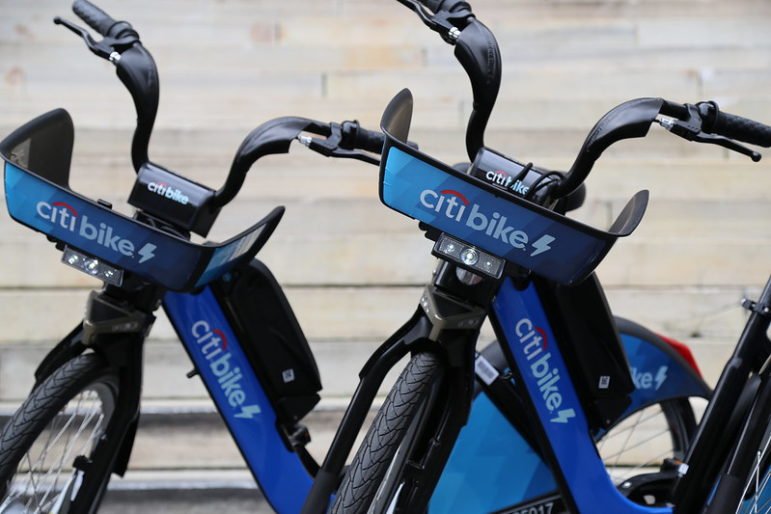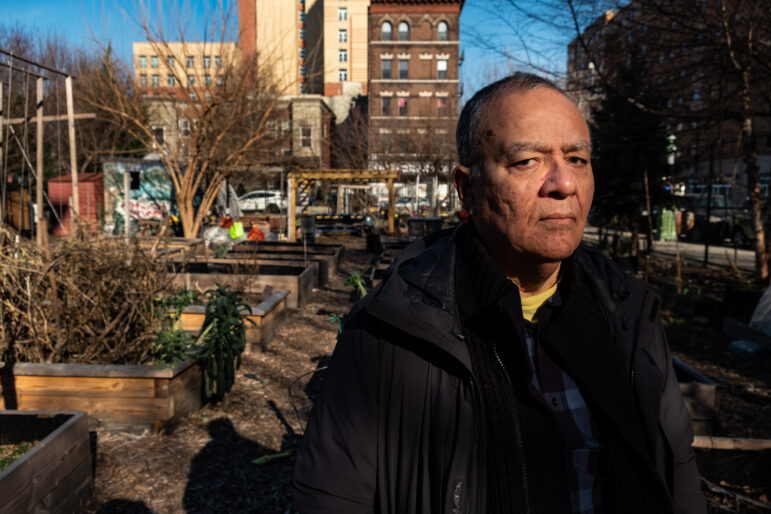“To get the most out of its vital investments in protected bike lanes, the city should pull every lever at its disposal to increase access to personal and shared e-bikes.”

Flickr/NYCDOT
Citi Bike’s pedal-assist electric bikes.Odds are you’ve seen an e-bike by now—and you may not have even noticed unless you felt that extra boost when you pedaled, helping inexperienced and expert cyclists alike cruise across the Manhattan Bridge without breaking much of a sweat, as I did on my way to visit friends in Bay Ridge recently.
It’s a difference maker for accessibility, unlocking clean and efficient micromobility for those who can’t power the full distance. That means a daunting bike commute can suddenly become a breeze, or a car trip to the grocery store can become a quick bike ride. Or maybe it’s just a typical commute to work for Councilmember Shahana Hanif, who, shortly after a hip replacement, rode an e-bike across the Brooklyn Bridge on “Bike to Work Day.”
With traffic rising, it’s more important than ever to rethink how we get around in New York City. On the heels of the recent rally held by Transportation Alternatives, New York League of Conservation Voters (NYLCV) and others, the city’s new budget includes funding to implement the NYC Streets Plan, including a robust bike lane network. To get the most out of its vital investments in protected bike lanes, the city should pull every lever at its disposal to increase access to personal and shared e-bikes.
Encouraging low-carbon transportation is a top priority in the climate fight. According to a recent study, active mobility such as walking, biking, or e-biking—even if it replaces just one car trip per week—“significantly lower[s] carbon footprints, even in European cities that already have a high incidence of walking and cycling.” But according to Dr. Audrey de Nazelle, a co-author of the study, people need to be nudged in the right direction—or given the opportunity to walk or bike in the first place.
There are several policy decisions within reach that could allow the city to harness this mushrooming demand for e-bikes and help meet its ambitious targets:
Incentivize e-bikes: The government can offer subsidies or tax credits for consumers who buy e-bikes—a $900 credit as part of the Build Back Better act never made it through the Senate last year, but any success on this front would make adoption easier. Likewise, the Bicycle Commuter Act would give employees up to $83/month in pre-tax dollars to invest in bike commuting expenses, including bike share memberships and e-bike costs. At the state level, there is legislation to establish a 50 percent rebate, up to $1,100, for the purchase of an e-bike or e-scooter that we hope to see adopted in next year’s budget.
Fund station electrification: Right now, bike share providers like Citi Bike have to drive vans around to swap out fresh batteries for dead ones. That means a lot of unnecessary vehicle miles on the road. Mayor Eric Adams’ recent “City of Yes” initiative offers an opportunity to reshape zoning laws to incentivize or even require developers to fund the electrification of Citi Bike stations close to their building site. That would cover the costly process of running wire to the station and provide the developers and their clients easy access to bikes. The city could also tap federal EV and safety funds to electrify Citi Bike stations, keeping the e-bike fleet more consistently charged.
Boost e-bike fleets: We need to introduce more e-bikes in bike share programs to account for widespread demand. Last year’s Citi Bike data, for example, shows that each e-bike was ridden about three times as many times per day as a pedal bike, with reduced-fare bike share members riding e-bikes at even higher rates than full-paying members. Close to 40 percent of rides were on e-bikes, although just 20 percent of the fleet is electric. This shift is crucial because e-bike trips tend to replace car trips, while traditional bike trips almost never do.
The bottom line: Transportation, which accounts for 30 percent of New York City’s carbon emissions and 27 percent of emissions across the U.S., needs to get greener, fast. In a study in Brighton, UK, providing access to e-bikes led to a 20 percent reduction in car mileage. Multiply that access across Boston, New York, Chicago, Los Angeles, and beyond—and America’s transportation future could be transformed.
If New York City hopes to achieve its goal of reducing emissions from public and private transportation methods by 80 percent by 2050, we need to start pedaling.
Julie Tighe is president of the New York League of Conservation Voters.









7 thoughts on “Opinion: How E-bikes Can Help NYC Reach its Climate Goals”
This is nothing but a commercial for citibike and other ebikes. And by the way. That march you did with transportation alternatives was based on a damned lie. The citibike rider who ran the red caused that accident. It was not the cab drivers fault.
Disclose this please: https://nylcvef.org/people/julie-tighe/
“Julie Tighe was named President of NYLCV and NYLCVEF in 2018. As President, she oversees the organizations’ policy, political, development, programmatic, and communications teams. Due in part to the League’s and her advocacy, the State enacted the Climate Leadership & Community Protection Act – the nation’s most progressive climate law, congestion pricing, the $3 Billion Restore Mother Nature Bond Act, the Accelerated Renewable Energy Growth & Community Benefit Act, and several other pieces of legislation to reduce emissions from the transportation and buildings sectors. She also helped secure increased State funding for water infrastructure and New York City funding for parks and open space.
This is PR… Really, really bad PR. And it’s a stain on your editorial board… WTF?
This is NOT the answer to reducing emissions from the public. It could be done better, but there’s too much money involved and this is New York.
I agree with the writer, but if safety concerns are not addressed, this idea will fail. Laws that are in place and possibly future regulations are needed to protect pedestrians. There are too many bikers, mostly on ebikes, going the wrong way in bike lanes, running red lights and riding on sidewalks. Enforcement needs to be stepped up so that we make room for all.
Non-driver/bus and subway user here and not in favor of any NYC bicycle expansion especially as bicyclists routinely endanger pedestrians – go through red lights, go the wrong way, ignore bike lanes, etc.
A few things:
In NYC, particularly Brooklyn and Manhattan, bicyclists, Citibike bicycle and Citibike e-bike users are mostly former mass transit users – not former drivers. (The Citibike demographic is mostly upscale and young). Thus it is MTA mass transit that is losing ridership to bicycles and e-bikes (and Revel vespa/moped).
Ecommerce, commercial vehicles and overdevelopment (construction, service etc) and street shrinkage (construction, bike lanes, streets closed) are the reasons for Manhattan traffic – not the stereotype of rich suburbanites driving in (they are working remotely). People who drive in are chiefly less affluent, living far away in transit deserts, people doing shift work – eg security guards, building maintenance etc.
Restaurant delivery e-bikes are another situation. These individuals work really hard and are exploited. But they would not be driving cars anyway.
Worth noting that parallel to the expansion of the NYC bicycle infrastructure (starting with Bloomberg), there have been continued cuts in MTA bus service – frequency and routes and bus stops. (The City contributes to the MTA) The City’s demographic policy preferences are pretty clear here.
BTW Uber and Lyft are big donors to the bicycle lobby, Transportation Alternatives.
Please pretend you went to journalism school and disclose the conflicts of your authors.
https://www.cleanfuelsny.org/news/letter-to-climate-action-council-calling-for-a-clean-fuel-standard
https://nyc.streetsblog.org/2021/11/12/the-parks-departments-e-bike-policy-is-not-consistent-with-state-law/
https://nyc.streetsblog.org/2021/03/15/city-hall-remains-silent-as-hudson-river-greenway-e-bike-ban-continues/
https://www.thirteen.org/programs/new-york-now/julie-tighe-build-back-better-bill-duxt1l/
Hi Steve, this is an opinion piece and the author’s bio we included along with it states that Tighe is the president of the NYLCV. Am I missing something?